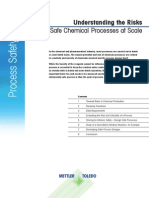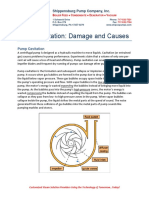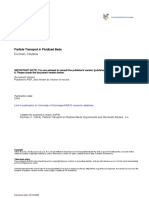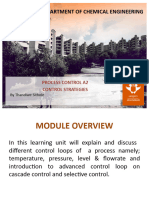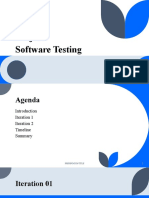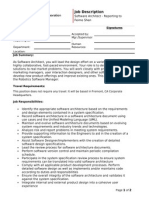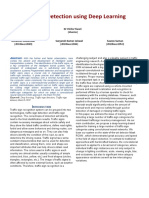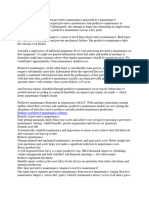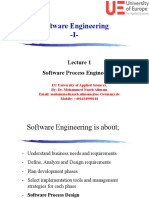Feed Forward Cascade Control
Feed Forward Cascade Control
Uploaded by
MiNiTexasCopyright:
Available Formats
Feed Forward Cascade Control
Feed Forward Cascade Control
Uploaded by
MiNiTexasCopyright
Available Formats
Share this document
Did you find this document useful?
Is this content inappropriate?
Copyright:
Available Formats
Feed Forward Cascade Control
Feed Forward Cascade Control
Uploaded by
MiNiTexasCopyright:
Available Formats
CHEE 3367, FF/FB & Cascade, M.
Nikolaou, page 1
CHEE3367 Process Dynamics and Control
M. Nikolaou, University of Houston
Improving disturbance rejection: Feedforward and Cascade Control
Table of Contents
1 Feedforward Control .............................................................................................................................. 1
1.1 What is Feedforward Control? ...................................................................................................... 1
1.2 Why Feedforward Control? .......................................................................................................... 1
1.3 General FF/FB design ...................................................................................................................... 3
2 Cascade Control...................................................................................................................................... 5
2.1 What is Cascade Control? ............................................................................................................. 5
2.2 Why Cascade Control? ..................................................................................................................... 5
2.3 Design of cascade controllers ........................................................................................................... 6
1 Feedforward Control
1.1 What is Feedforward Control?
Control strategy using measured disturbances. Must be combined with feedback, because there is always
some uncertainty in (a) unmeasured disturbances, (b) Process behavior (model).
Process
Unmeasured
disturbances
Manipulated
inputs
Measured
disturbances
Unmeasure
d outputs
Measured
outputs
Controlle
r
Feedforward
path
Feedback path
Figure 1 Feedback loop
1.2 Why Feedforward Control?
To compensate for measured disturbances. Feedforward takes corrective action before disturbance effects
are felt on process outputs, thereby allowing better disturbance rejection.
EXAMPLE 1 Feedforward / Feedback control of a tank heater
System: Tank heater.
Manipulated input: Q
Measured disturbance:
i
T
Controlled output: T
CHEE 3367, FF/FB & Cascade, M. Nikolaou, page 2
Figure 2 Heater schematic
Dynamics:
| |
( )
( ) ( )
i
p
dT F Q t
T t T t
dt V C V
= +
Linearized dynamics in deviation from steady state:
1
1 1
( ) ( ) ( ) ( ) ( ) ( )
1 1
p
i i
p
C F
d T F F
T t T t Q t T s T t Q t
V V
dt V V C V
s s
F F
A
= A A + A A = A + A
+ +
Figure 3 Feedforward/Feedback loop schematic for Example
| |
1
( ) ( ) ( ) ( ) ( )
1 ( ) ( )
( ) 1
( )
( )
1
0
1 ( ) ( )
FF i
FB
FF
FB
T s D s G s C s T s
G s C s
D s
C s
G s K
G s C s
A = + A
+
~ =
~
+
Design ( )
FB
C s using IMC.
Numerical simulation: Assume 10 K = , 1 t = , 12 K = , 0.8 t = .
Setpoint
T
SP
e
Output, T
Noise
n
-
G C
FB
Input
Q
Measured Disturbance
T
i
D
C
FF
F, T
i
F, T
T
c
V
CHEE 3367, FF/FB & Cascade, M. Nikolaou, page 3
Figure 4 Comparison between Feedforward/Feedback and Feedback
1.3 General FF/FB design
Figure 5 Feedforward/Feedback loop schematic
| |
1
( ) ( ) ( ) ( ) ( )
1 ( ) ( )
( )
( )
( )
1
0
1 ( ) ( )
FF
FB
FF
FB
y s D s G s C s d s
G s C s
D s
C s
G s
G s C s
A = + A
+
~
~
+
- Design of ( )
FF
C s
In general, ( )
FF
C s must be stable, proper (degree of numerator s degree of denominator). If not, use the
same approach as in the design of Q in IMC, i.e.
Setpoint
ySP
e
Output, y
Noise
n
-
G C
FB
Input
u
Measured Disturbance
d
D
C
FF
CHEE 3367, FF/FB & Cascade, M. Nikolaou, page 4
( )
( ) ( )
( )
FF
D s
C s F s
G s
~ (1)
where
1
( )
( 1)
r
F s
s
=
+
(2)
If
1
( ) G s
is not stable or not causal, then modify the following factors of
1
( ) G s
1 1
s a s a
(to eliminate unstable poles)
1
s
e
+u
(to eliminate non-causal terms)
- Design of ( )
FB
C s
Use standard IMC or other PID design methods.
CHEE 3367, FF/FB & Cascade, M. Nikolaou, page 5
2 Cascade Control
2.1 What is Cascade Control?
A control scheme composed of two nested feedback loops, in which the controller of the outer loop
produces the setpoint of the inner loop (see Figure 6).
Figure 6 Classical and cascade control loops. The controller command v is
perturbed by the input disturbance d .
2.2 Why Cascade Control?
To better reject input disturbances that tend to alter the commands (manipulated inputs) sent to the process
by the controller.
EXAMPLE 2 Cascade control configuration for a furnace
A furnace fueled by natural gas is used to preheat a high-molecular-weight (C
16
to C
26
) hydrocarbon feed to
a cracking unit in a petroleum refinery (see schematic below).
The main control objective of this unit is to maintain the temperature of the heated hydrocarbon at setpoint.
To achieve this, the valve opening of the fuel gas flow line is adjusted to use fuel gas pressure as
manipulated input.
The main disturbance d to the system is fluctuations in the fuel gas supply pressure.
To control this system, we will compare standard feedback and cascade feedback control loops, as shown
in the following figure.
C
2
C
1
-1
-1
G
2
G
1
d
y
u
v
u
SP
y
SP
C
-1
G
2
G
1
d
u
v
y
SP
y
CHEE 3367, FF/FB & Cascade, M. Nikolaou, page 6
Figure 7 Classical and cascade control loops for an industrial furnace. The
corresponding block diagrams are shown in Figure 8 below.
Figure 8 Classical and cascade control loops.
2.3 Design of cascade controllers
- Substitute inner loop (Figure 6b):
C
-1
G
2
G
1
d
P
v
T
SP
T
C
2
C
1
-1
-1
G
2
G
1
d
T
P
v
P
SP
T
SP
P
P
SP
B Bu ur rn ne er r
Inlet
hydrocarbon
Outlet (heated)
hydrocarbon
Exhaust gas
TC
T
SP T
PC
v
B Bu ur rn ne er r
Inlet
hydrocarbon
Outlet (heated)
hydrocarbon
Fuel gas
Exhaust gas
TC
T
SP T
v
CHEE 3367, FF/FB & Cascade, M. Nikolaou, page 7
( )
2
2 2 2 2
2
2 2 2 2
1
1
1 1
SP
d
SP SP SP
SP d
G
G
G
u u d G Q u G Q d G u G d
C
G C G C
= + = + =
+
+
+
(3)
Figure 9 Cascade control configuration equivalent to Figure 6b (for design
purposes) with inner loop replaced.
- Transfer functions for entire closed loop (Figure 9).
( )
( )
1
1 1 1 1 1
1 1
1 2 2 1 1 2 2
1
1
1
2 2
1
2
1
1
1
1 ) 1
1
(
SP SP
d
SP SP SP
d SP SP d
SP
SP
G G
P
G
S
GG
y y G d GG Q y GG Q GG d
GG C
G G Q Q y G G Q Q G G
C
G
Q
C
d
G +
= + = +
+
= +
( )
1 2 2 1 1 2 2 2 1 2 2
(1 ) 1
d
SP
Q Q
G
y GG Q Q y GG Q Q G G Q d = + (4)
- Compare to standard feedback loop (Figure 6a):
1
2 2
1
1
2
1
1 1
SP
GG G
y y d
G
C
G G C G C + +
= +
( )
1 2 1 2 1
1
SP
y GG Qy GG Q Gd = + (5)
Eqns. (5) and (4) show that the effect of the setpoint
SP
y on y is similar for both the standard and cascade
control loops, but the effect of the input disturbance d on y is ( )
1 2 2 2 1 2 2
(1 ) 1
d
Q
G
GG Q Q G G Q d for the
cascade vs. ( )
1 2 1
1 GG Q Gd for the standard feedback loop. The extra term
2 2
1
d
G G Q = in the cascade
configuration can be designed to be very small (How? How small?)
Therefore, the cascade control loop can reject d much better than standard feedback loop.
EXAMPLE 3 Design of cascade controllers for the furnace in EXAMPLE 2
Process transfer functions (with all time constants in minutes and all variables in deviation form):
1
exp[ 2 ]
( ) ( )
5 1
( )
s
T s P s
s
G s
A = A
+
,
2
exp[ 0.05 ]
( ) ( )
0.4 1
( )
s
P s v s
s
G s
A = A
+
where dead-time uncertainty is 50% for both transfer functions.
- Standard feedback loop (Figure 8a):
-
G
Inner_loop_setpoint
C
1
-1
G
1
d
y
u
y
SP
u
SP
G
Inner_loop_disturbance
CHEE 3367, FF/FB & Cascade, M. Nikolaou, page 8
1
1 2
( ) ( ) exp[ 2.05 ] exp[ 2 ]
[1 ( ) ( )] ( ) 1
( ) 1 ( ) ( ) 5 1 ( 1)
G s T s s s
G s Q s G s
d s G s C s s s
( A
= = =
(
A + + +
where 1.025 1 = ~ .
- Cascade control loop ((Figure 8b):
o Replace inner loop for design purposes:
Inner_loop_setpoint Inner_loop_disturbance
2 2 2 2
2 2
( ) ( ) ( ) ( ) [1 ( ) ( )] ( )
exp[ 0.05 ] exp[ 0.05 ]
( ) 1 ( )
1 1
SP
SP
G G
P s G s Q s P s G s Q s d s
s s
P s d s
s s
A = A + A
(
= A + A
(
+ +
where
2
0.025 = .
o Design outer loop:
Inner_loop_disturbance
Inner_loop_disturbance
1 Inner_loop_disturbance 1
2
2
( )
( )
( ) ( )[1 ( ) ( )] ( )
( ) 1 ( ) ( )
exp[ 0.05 ] exp[ 2.05 ] exp[ 2 ]
1 1
1 5 1 ( 1)
G
G s
T s
G s G s G s Q s G s
d s G s C s
s s s
s s s
A
= =
A +
( (
=
( (
+ + +
where 1.025 1 = ~
The term
2
exp[ 0.05 ]
1
1
s
s
(
(
+
in
( )
( )
T s
d s
A
A
for the cascade loop and the fact that
2
0.025 = (small) makes
cascade control reject input disturbances faster. In fact, for the low-frequency (
2
1
e
<< ) content of a
disturbance
2
exp[ 0.05 ]
1 0
1
s
s
(
~
(
+
.
Verify design by simulation using Simulink.
CHEE 3367, FF/FB & Cascade, M. Nikolaou, page 9
CHEE 3367, FF/FB & Cascade, M. Nikolaou, page 10
You might also like
- Capstone Online Agricultural Product StoreDocument48 pagesCapstone Online Agricultural Product Storepriyanka allaka100% (2)
- Cascade ControlDocument17 pagesCascade Controlمحمد سلامNo ratings yet
- Chap01 - A Career in Process ControlDocument44 pagesChap01 - A Career in Process ControlKeith MaddenNo ratings yet
- CPB 30004 - CHAPTER 1 - INTRO Sept 2014Document52 pagesCPB 30004 - CHAPTER 1 - INTRO Sept 2014Ashwin MNo ratings yet
- TeDocument67 pagesTeYudha Sanditya SaputraNo ratings yet
- Total Systemic Failure? (Garnett, 2018) Science of The Total EnvironmentDocument5 pagesTotal Systemic Failure? (Garnett, 2018) Science of The Total EnvironmentCliffhangerNo ratings yet
- Cascade Control: (Chap 9 in Book and 10 in Edition 2)Document6 pagesCascade Control: (Chap 9 in Book and 10 in Edition 2)yungPNo ratings yet
- Comparison Between Conventional PID and Fuzzy Logic ControllerDocument5 pagesComparison Between Conventional PID and Fuzzy Logic ControllerSidiNo ratings yet
- 13 Cascade ControlDocument39 pages13 Cascade ControlMansour AbdulazizNo ratings yet
- Traditional Advanced Control StrategiesDocument48 pagesTraditional Advanced Control Strategiescape iipeNo ratings yet
- Workshop#10 Report - Cascade Control of Jacketed Reactor - Roy - StewartDocument14 pagesWorkshop#10 Report - Cascade Control of Jacketed Reactor - Roy - Stewartdevbones18No ratings yet
- Control Loops 2Document22 pagesControl Loops 2Muntadher AbbasNo ratings yet
- Ball Lightining Teslas Production of Electric Fireballs PDFDocument5 pagesBall Lightining Teslas Production of Electric Fireballs PDFFreakbizarro100% (1)
- Chapter 2-1Document22 pagesChapter 2-1Fathi ShokryNo ratings yet
- Process Control Chap 9 Cascade ControlDocument20 pagesProcess Control Chap 9 Cascade ControlAishah RashiddiNo ratings yet
- ControlDocument43 pagesControlaramNo ratings yet
- Unit-1 Control System Analysis and ComponentsDocument10 pagesUnit-1 Control System Analysis and ComponentsBrooke HollandNo ratings yet
- Manipulated Variable: Cascade ControlDocument2 pagesManipulated Variable: Cascade ControlAbu SyakirahNo ratings yet
- Controlled Variable Manipulated Variable Controlle R Type /scheme Gproms Model/Process NameDocument5 pagesControlled Variable Manipulated Variable Controlle R Type /scheme Gproms Model/Process NameJoseph OrjiNo ratings yet
- Loss Prevention in Chemical Industries InvolveDocument29 pagesLoss Prevention in Chemical Industries Involveferi qodriNo ratings yet
- Cascade Control Signal Distribution BlockDocument4 pagesCascade Control Signal Distribution BlockFelipeNo ratings yet
- Process Description of MtbeDocument3 pagesProcess Description of Mtbeiszhani11No ratings yet
- Flashing LiquidsDocument31 pagesFlashing LiquidsAmerNo ratings yet
- Plant Location and LayoutDocument11 pagesPlant Location and LayoutashutoshNo ratings yet
- Process SafetyDocument12 pagesProcess SafetyTiotet33No ratings yet
- Howto PFD Development PDF PDFDocument74 pagesHowto PFD Development PDF PDFcahz1307No ratings yet
- The ECOSSE Control HyperCourseDocument234 pagesThe ECOSSE Control HyperCoursefri_13thNo ratings yet
- Separation Process in Oil and Gas - Part-2 by Anand PatelDocument10 pagesSeparation Process in Oil and Gas - Part-2 by Anand PatelAbderrahmane AbderrahmaniNo ratings yet
- Cascade Control System 1Document20 pagesCascade Control System 1IffatNo ratings yet
- Industrial Process DesignDocument44 pagesIndustrial Process DesigntruchitoNo ratings yet
- Pump Cavitation - Damages and CausesDocument3 pagesPump Cavitation - Damages and CausesWilliam MaNo ratings yet
- Seperators PresentationDocument20 pagesSeperators PresentationAhmed JafferNo ratings yet
- Plant Location and Lay-OutDocument26 pagesPlant Location and Lay-OutJoy Maan De GuzmanNo ratings yet
- Control Loop CharacteristicsDocument10 pagesControl Loop CharacteristicsJohn Russell MoralesNo ratings yet
- Material Selection Consideration For ReactorsDocument6 pagesMaterial Selection Consideration For ReactorsMiera Yushira YusoffNo ratings yet
- Foam Dam Brochure REV 0 1210Document2 pagesFoam Dam Brochure REV 0 1210Ildegar PuertaNo ratings yet
- Catalytic Conversion of C4 Fraction For The Production of Light OlefinsDocument5 pagesCatalytic Conversion of C4 Fraction For The Production of Light Olefinsaegosmith100% (1)
- Model Evaluation For An Industrial Process of Direct Chlorination of Ethylene in A Bubble-Column Reactor With External Reci PDFDocument11 pagesModel Evaluation For An Industrial Process of Direct Chlorination of Ethylene in A Bubble-Column Reactor With External Reci PDFyamakunNo ratings yet
- Test 1 ECE CDB3022 - CEB3013 - May 2020Document7 pagesTest 1 ECE CDB3022 - CEB3013 - May 2020Ahmed AlwaqediNo ratings yet
- CHEN3005 Process Instrumentation and ControlDocument4 pagesCHEN3005 Process Instrumentation and ControlVincent Ys TanNo ratings yet
- Kinetics of Toluene Alkylation With Methanol Over Mg-Modified ZSM-5Document7 pagesKinetics of Toluene Alkylation With Methanol Over Mg-Modified ZSM-5Mikee FelipeNo ratings yet
- Tutorial 1 SolutionDocument3 pagesTutorial 1 Solutionpleco4meNo ratings yet
- Tce5002 Introduction To PDC, Modelling Simulation & ControlDocument15 pagesTce5002 Introduction To PDC, Modelling Simulation & ControlKundayi ChagwederaNo ratings yet
- Cascade Control: 25.1 Master and Slave LoopsDocument10 pagesCascade Control: 25.1 Master and Slave Loopsdeepak pandeyNo ratings yet
- Flash Drum Simulation Using Aspen HYSYS To Remove Hydrogen From MethaneDocument12 pagesFlash Drum Simulation Using Aspen HYSYS To Remove Hydrogen From MethaneFloyd BurgessNo ratings yet
- Dist06 ExtendedDocument29 pagesDist06 ExtendedjokishNo ratings yet
- Chemical Process DynamicsDocument19 pagesChemical Process DynamicsFarid Al-FansuriNo ratings yet
- Literature On FluidizationDocument23 pagesLiterature On FluidizationRafique AjmeriNo ratings yet
- IOSR JournalsDocument6 pagesIOSR JournalsInternational Organization of Scientific Research (IOSR)No ratings yet
- Override and Selective ControlDocument16 pagesOverride and Selective ControlPrasef Karl Andres Cortes IIINo ratings yet
- 1 s2.0 S0263876299717624 MainDocument7 pages1 s2.0 S0263876299717624 Mainryan123459No ratings yet
- Process Control SystemDocument8 pagesProcess Control SystemIno JohannisNo ratings yet
- Processes 09 00207 v2Document19 pagesProcesses 09 00207 v2Hamza AliNo ratings yet
- CEP - Modeling Reactive AbsorptionDocument9 pagesCEP - Modeling Reactive Absorptionnp484No ratings yet
- 02 Overview of Process ControlDocument23 pages02 Overview of Process ControlSatyam SaranNo ratings yet
- Lectures 2 PDFDocument7 pagesLectures 2 PDFshubhamNo ratings yet
- Unit 4 CONTROL STRATEGIESDocument34 pagesUnit 4 CONTROL STRATEGIESthandiswan123No ratings yet
- Temperature Control ApplicationDocument22 pagesTemperature Control Applicationsyafiq izzuddin bin sapriNo ratings yet
- 4-20 MA Process Control Loops - DCS Control Loop - Inst ToolsDocument8 pages4-20 MA Process Control Loops - DCS Control Loop - Inst Toolskali bangonNo ratings yet
- Controller Design Based On Transient Response CriteriaDocument20 pagesController Design Based On Transient Response CriteriaGapuk MaboekNo ratings yet
- Control of DC Motor Using Different Control StrategiesFrom EverandControl of DC Motor Using Different Control StrategiesNo ratings yet
- Stproject SlidesDocument25 pagesStproject SlidesShahid ImranNo ratings yet
- What Is A Data Lake - Definition From SearchDataManagementDocument11 pagesWhat Is A Data Lake - Definition From SearchDataManagementAhmed khaled mohamed seadaNo ratings yet
- Self-Driving Car Engineer Nanodegree SyllabusDocument7 pagesSelf-Driving Car Engineer Nanodegree SyllabusKapildev KumarNo ratings yet
- Software Architect Job DescriptionDocument2 pagesSoftware Architect Job DescriptionSababathi BalakrishnanNo ratings yet
- Eee4093 QFTDocument43 pagesEee4093 QFTJames GillardNo ratings yet
- Software Engineering - NotesDocument109 pagesSoftware Engineering - NotesAravind Surya100% (3)
- Midterm Exam Paper No.1: EE2001E: Signals and SystemsDocument2 pagesMidterm Exam Paper No.1: EE2001E: Signals and SystemsHưng NguyễnNo ratings yet
- BABOK 2 Big PictureDocument1 pageBABOK 2 Big PictureCBAPMaster100% (3)
- Neurophys 7 MetaneuronsDocument18 pagesNeurophys 7 Metaneurons王榮椿No ratings yet
- Unit - 1 (Introduction To SAD)Document12 pagesUnit - 1 (Introduction To SAD)arvindk.online6095100% (1)
- No. 3 Lean System PDFDocument25 pagesNo. 3 Lean System PDFPrashant GunahNo ratings yet
- Traffic Sign DetectionDocument5 pagesTraffic Sign DetectionSameer SinghNo ratings yet
- UNIT-4 Verification Plan: LVS-22 Vlsi Testing and VerificationDocument8 pagesUNIT-4 Verification Plan: LVS-22 Vlsi Testing and VerificationSanthoshReddyNo ratings yet
- Advanced Controllers For Feed Drives: Keynote PaperDocument10 pagesAdvanced Controllers For Feed Drives: Keynote PaperVASILIINo ratings yet
- Geng4402 - Assignment 2: Question 1 - Nyquist Plot/Frequency Response PerformanceDocument9 pagesGeng4402 - Assignment 2: Question 1 - Nyquist Plot/Frequency Response PerformanceangelosoutiNo ratings yet
- Job Hazard AnalysisDocument35 pagesJob Hazard AnalysisVrigin Kathleen de Castro100% (2)
- Fault Tolerant ComputingDocument4 pagesFault Tolerant ComputingMayowa SunusiNo ratings yet
- How To Use The 5 Whys: and Introduction To Failure Mode and Effects Analysis (FMEA)Document16 pagesHow To Use The 5 Whys: and Introduction To Failure Mode and Effects Analysis (FMEA)Jhonrick MagtibayNo ratings yet
- Explore A Predictive Maintenance SolutionDocument2 pagesExplore A Predictive Maintenance SolutionJevan CalqNo ratings yet
- Chatgpt PDFDocument1 pageChatgpt PDFPorcia ScriptsNo ratings yet
- Design of PI and PID Controllers With Transient Performance SpecificationDocument8 pagesDesign of PI and PID Controllers With Transient Performance SpecificationJaime Alberto Parra PlazasNo ratings yet
- Expert System ArchitectureDocument5 pagesExpert System ArchitectureaadafullNo ratings yet
- 1.software Development ProcessDocument74 pages1.software Development ProcessLavanya KiniNo ratings yet
- Minor Project 2 Shubham Bahri Bca MDocument78 pagesMinor Project 2 Shubham Bahri Bca MRajesh KumarNo ratings yet
- Software Engineering - IDocument22 pagesSoftware Engineering - IKubo PitonakNo ratings yet
- UNIT-2 Requirement EngineeringDocument28 pagesUNIT-2 Requirement EngineeringAnuj MishraNo ratings yet
- City Guide SystemDocument18 pagesCity Guide SystemNeela RaiNo ratings yet
- SCRUM (Mind Mapping)Document1 pageSCRUM (Mind Mapping)Rounak VijayNo ratings yet
























